The Future of Oracle BI Beans
A question I've often been asked over the last year or so is "what's happening with Oracle BI Beans?" For anyone not aware of what BI Beans is/are, it's a J2EE component set that connects to Oracle OLAP via the Java OLAP API and was used as the building blocks for the OLAP version of Oracle BI Discoverer. Whilst Discoverer and Oracle OLAP have had releases, or announcements, about 11g versions, it's been a bit quiet on the BI Beans front with various rumours going around that the product was being discontinued, or at least merged into JDeveloper (rather than being a product line on its own, which was always a bit strange for a set of Java components).
I was taking a look therefore at the latest Oracle OLAP newsletter when I saw a mention of what's planned for BI Beans in the 10g release and what's coming up in the 11g timeframe. To quote the newsletter:
"Oracle BI Beans 10.1.2.x is planned to be certified to work with Oracle OLAP 11g. BI Beans are being repackaged as ADF Data Visualization components (ADF DVT). These components are available in JDeveloper 11g and include Graph, Gauge, Geographic Map, Gantt Chart, and Pivot Table. DVT components work against pure relational as well as OBI EE data sources using standard ADF Data Control mechanism. In the first release of 11g direct access to OLAP cubes from the DVT components will be via SQL through the ADF BC layer or directly via Java code."
My guess here is that BI Beans 10.1.2.x will be certified with Oracle OLAP 11g in 10g OLAP mode, as the main access method for the 11g OLAP mode is through SQL. Looking at the statement, this would follow as in their current form, DVT components use an SQL query to access their data, although the door does seem to be open for some further OLAP access optimization in a future release, whether this will be through the Java OLAP API (is this supported in 11g OLAP mode?) or some other method is obviously yet to be determined.
Taking a look at Data Visualization Components, they look pretty neat, and the graphing components seem to be a derivation of the code that was used to deliver graphs in the 10gR2 version of Discoverer, which of course had to support both OLAP API and SQL access.
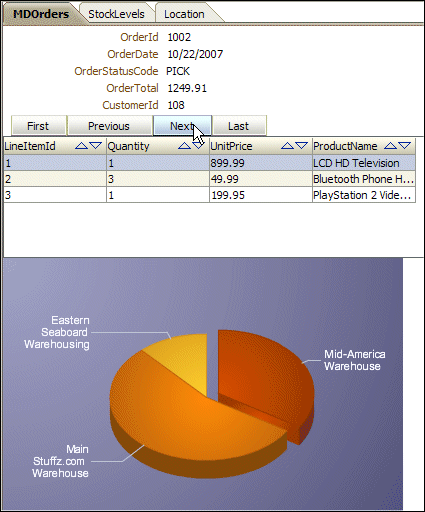
Looking at the graphing options available, there's quite a few more than are in the 10g version of Discoverer though, with funnel and gantt charts now available as well.
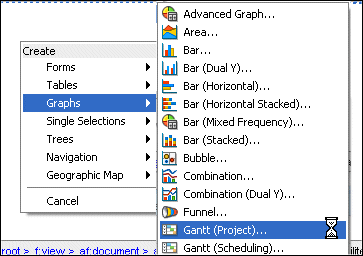
Something that's new with DVT is a map component, that lets you take data from an SQL query and render it in a map. I wonder if it's support maps other than for the USA?
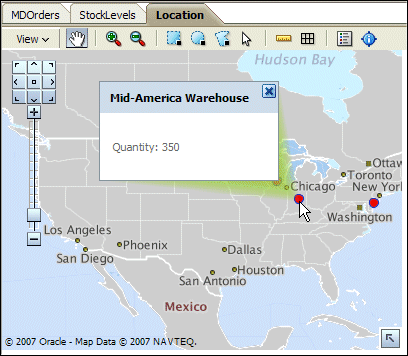
There's also what appears to be a thin-client, interactive pivot table (crosstab) component - one of the drawbacks with BI Beans was that the interactive, drag-and-drop crosstab was thick-client, Java applet only, whilst the thin-client version only allowed manipulation via drop-down menus and page reloads. From screenshots I've seen of Answers Plus (the next, OLAP analysis-capable version of Oracle BI Answers) the crosstabs it uses seem to use this style of pivot table, so I guess DVT is the technology they're building this on - just a guess though.
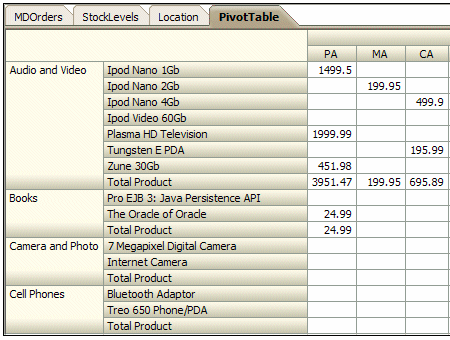
Here's the drag-and-drop ability, pivoting one dimension with another.
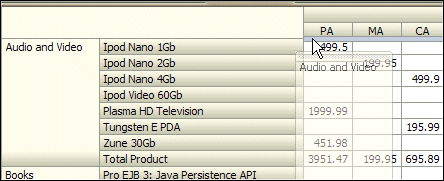
Looking through the Oracle-by-Example linked to earlier, what does seem to be missing is any sort of query builder you can put into your application; one of the major plus points of BI Beans was the OLAP query builder you could add to a project, giving you the same ability to build queries that you see in Oracle BI Discoverer for OLAP. I couldn't see anything beyond an SQL expression builder in DVT, obviously in DVT we'd lose any OLAP elements of a query builder (select dimension members via a hierarchy, that sort of thing) but there doesn't appear to be anything in DVT beyond a simple editor for an SQL query. It looks like DVT is something you use for adding data vizualizations to your application rather than building your own answer to Discoverer.
Anyway, I guess this answers the question about what's happening with BI Beans. The existing 10g version will be certified to work against 11g OLAP, my guess is in 10g OLAP mode. For 11g OLAP access through SQL queries (or through the Cube Materialized View feature) and SQL queries in general, these new Data Visualization Components seem to be a spruced-up, thin-client version of BI Beans, albeit without an OLAP query builder or their own slightly abstracted Java API into Oracle OLAP, though as I said the statement on the Oracle OLAP newsletter does seem to suggest that more OLAP functionality might come in a subsequent release.